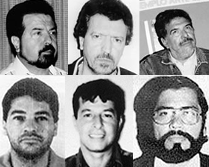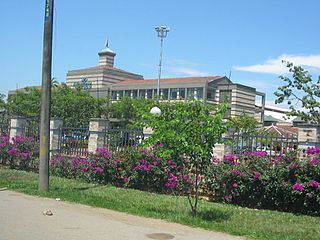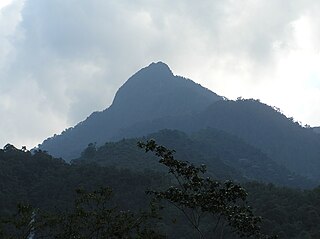
Transport in Colombia is regulated by the Ministry of Transport.

Santiago de Cali, or Cali, is the capital of the Valle del Cauca department, and the most populous city in southwest Colombia, with 2,280,522 residents estimate by DANE in 2023. The city spans 560.3 km2 (216.3 sq mi) with 120.9 km2 (46.7 sq mi) of urban area, making Cali the second-largest city in the country by area and the third most populous after Bogotá and Medellín. As the only major Colombian city with access to the Pacific Coast, Cali is the main urban and economic center in the south of the country, and has one of Colombia's fastest-growing economies. The city was founded on 25 July 1536 by the Spanish explorer Sebastián de Belalcázar.

The Cali Cartel was a drug cartel based in southern Colombia, around the city of Cali and the Valle del Cauca. Its founders were the brothers Gilberto Rodríguez Orejuela, Miguel Rodríguez Orejuela and José Santacruz Londoño. They broke away from Pablo Escobar and his Medellín associates in 1988, when Hélmer "Pacho" Herrera joined what became a four-man executive board that ran the cartel.

Valle del Cauca, or Cauca Valley, is a department in western Colombia abutting the Pacific Ocean. Its capital is Santiago de Cali. Other cities such as Buenaventura, Buga, Cartago, Palmira and Tuluá have great economical, political, social and cultural influence on the department's life. Valle del Cauca has the largest number of independent towns with over 100,000 inhabitants in the country, counting six within its borders. Buenaventura has the largest and busiest seaport in Colombia, moving about 8,500,000 tons of merchandise annually.

Alfonso Bonilla Aragón International Airport, formerly known as Palmaseca International Airport, is an international airport located between Palmira and Cali, the capital of Valle del Cauca Department, Colombia. It is Colombia's fourth-busiest airport in passenger volume, with 5,600,000 people using the airport in 2016, and the third largest in area and construction. The airport often serves as the alternate airport for Bogotá - El Dorado Int'l Airport and other Colombian airports.

América de Cali S. A., best known as América de Cali or América, is a Colombian professional football club based in Cali. It competes in the Categoría Primera A, the top-flight league of Colombian football. The team plays its home games at the Estadio Olímpico Pascual Guerrero, one of the most important stadiums in the country.

Asociación Deportivo Cali, best known as Deportivo Cali, is a Colombian sports club based in Cali, most notable for its football team, which currently competes in the Categoría Primera A.

Palmira is a city and municipality in southwestern Colombia in the Valle del Cauca Department, located about 27 kilometres (17 mi) east from Cali, the department's capital and main city in the South of Colombia. Palmira is the second largest city in the Valle del Cauca, behind Cali.

The Cordillera Occidental is the lowest in elevation of the three branches of the Colombian Andes. The average altitude is 2,000 m (6,600 ft) and the highest peak is Cerro Tatamá at 4,100 m (13,500 ft). The range extends from south to north dividing from the Colombian Massif in Nariño Department, passes north through Cauca, Valle del Cauca, Risaralda, Chocó, and Caldas Departments to the Paramillo Massif in Antioquia and Córdoba Departments. The cordillera is paralleled on the east by the Cauca river. From this massif the range divides further to form the Serranías de Ayapel, San Jerónimo and Abibe. Only to recede into the Caribbean plain and the Sinú River valley.
Jairo Leonard Patiño Rosero is a Colombian retired professional footballer who played as a midfielder.
Martín Cardetti is an Argentine football manager and former player who played as a forward. He played professional club football in Argentina, Spain, France, Mexico, Uruguay and Colombia. He is the current manager of Colombian club Llaneros.

The Andean region, located in central Colombia, is the most populated natural region of Colombia. With many mountains, the Andes contain most of the country's urban centers. They were also the location of the most significant pre-Columbian indigenous settlements. Beyond the Colombian Massif in the south-western departments of Cauca and Nariño, the Colombian Andes divide into three branches known as "cordilleras" : the West Andes run adjacent to the Pacific coast and is home to the city of Cali. The Central Andes run up the center of the country between the Cauca and Magdalena river valleys and includes the cities of Medellín, Manizales and Pereira. The East Andes extend northeast towards the Guajira Peninsula, and includes the cities of Bogotá, Bucaramanga and Cúcuta.

Jamundí is a town and municipality in the Department of Valle del Cauca, Colombia.
Jersson Amur González Díaz is a Colombian football manager and former footballer who played as a defender or a defensive midfielder.

Torre de Cali is a 44-story skyscraper in the northern part of Cali, Colombia. It lies with the Versalles district on the left bank of the Cali River. With 183 m it is the tallest building in Cali and among the tallest in Colombia. Due to its dominance of the Cali skyline it has become a landmark building of the city.

Farallones de Cali is a cluster of mountains in the West Andes of Colombia. It is located west of the city of Cali and gives rise to many of the rivers that provide water and electricity to Cali. The PNN Farallones de Cali encompasses 150,000 ha (580 sq mi) in the mountains as well as much of the Pacific slope and is an area of very high biodiversity. The average temperature ranges from 25 °C (77 °F) in the tropical foothills to 5 °C (41 °F) in the páramo. In this territory are located the district of Pichinde, Andes and Leonera, and two villages Penas Blancas and Lomas de la Cajita.
The 1996 Copa Libertadores final was a two-legged football match-up to determine the 1996 Copa Libertadores champion. It was contested by Argentine club River Plate and Colombian club América de Cali. The first leg was played at Pascual Guerrero Stadium in Cali, while the second leg was held in Estadio Monumental of Buenos Aires.

Lebanese Colombians are Colombians of Lebanese descent. Most of the Lebanese community's forebears immigrated to Colombia from the Ottoman Empire in the late 19th and early 20th centuries for economic, political and religious reasons. The first Lebanese moved to Colombia in the late nineteenth century. There was another wave in the early twentieth century. It is estimated that over 10,000 Lebanese immigrated to Colombia from 1900 to 1930.

The 1986 Copa Libertadores final was a two-legged football match-up to determine the 1986 Copa Libertadores champion.

Rafael Santos Borré Maury is a Colombian professional footballer who plays as a forward for Campeonato Brasileiro Série A club Internacional and the Colombia national team.

















